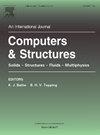多边形元的最低阶神经逼近虚元法
IF 4.8
2区 工程技术
Q1 COMPUTER SCIENCE, INTERDISCIPLINARY APPLICATIONS
引用次数: 0
摘要
本文提出了多边形元的最低阶神经逼近虚元法。该方法利用神经网络局部逼近虚元基函数,从而消除了标准虚元法的关键组成部分——稳定算子和投影算子问题。通过引入神经网络,将虚拟基函数逼近的计算负担转移到离线阶段,使该方法与在线装配阶段的有限元方法保持一致。我们改进了原先主要针对四边形元素设计的方法,通过附加谐波函数来细化局部逼近空间,以提高神经网络在多边形元素上的精度。此外,我们提出并分析了不同的训练策略,每种策略都提供了不同程度的准确性,并得到了理论论证的支持。我们进行了几个数值实验来验证我们的程序在相当一般的多边形网格上,并证明了所提出的方法在不同问题公式中的优势,特别是在大量使用投影和稳定项可能对标准版本的方法构成挑战的情况下。特别要注意的是具有悬挂节点的三角形网格,它在许多虚拟元素应用中起着中心作用。本文章由计算机程序翻译,如有差异,请以英文原文为准。
The lowest-order neural approximated virtual element method on polygonal elements
The lowest-order neural approximated virtual element method on polygonal elements is proposed here. This method employs a neural network to locally approximate the virtual element basis functions, thereby eliminating issues concerning stabilization and projection operators, which are the key components of the standard virtual element method. By employing neural networks, the computational burden of approximating the virtual basis functions is shifted to the offline phase, aligning the novel method with the finite element method in the online assembling phase. We enhance the original approach, mainly designed for quadrilateral elements, by refining the local approximation space with additional harmonic functions to improve the neural network’s accuracy on polygonal elements. Furthermore, we propose and analyze different training strategies, each offering varying levels of accuracy and supported by theoretical justifications. Several numerical experiments are conducted to validate our procedure on quite general polygonal meshes and demonstrate the advantages of the proposed method across different problem formulations, particularly in cases where the heavy usage of projection and stabilization terms may represent challenges for the standard version of the method. Particular attention is reserved for triangular meshes with hanging nodes which assume a central role in many virtual element applications.
求助全文
通过发布文献求助,成功后即可免费获取论文全文。
去求助
来源期刊

Computers & Structures
工程技术-工程:土木
CiteScore
8.80
自引率
6.40%
发文量
122
审稿时长
33 days
期刊介绍:
Computers & Structures publishes advances in the development and use of computational methods for the solution of problems in engineering and the sciences. The range of appropriate contributions is wide, and includes papers on establishing appropriate mathematical models and their numerical solution in all areas of mechanics. The journal also includes articles that present a substantial review of a field in the topics of the journal.
 求助内容:
求助内容: 应助结果提醒方式:
应助结果提醒方式:


